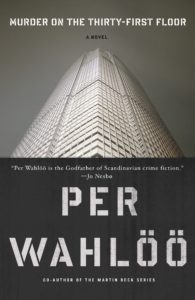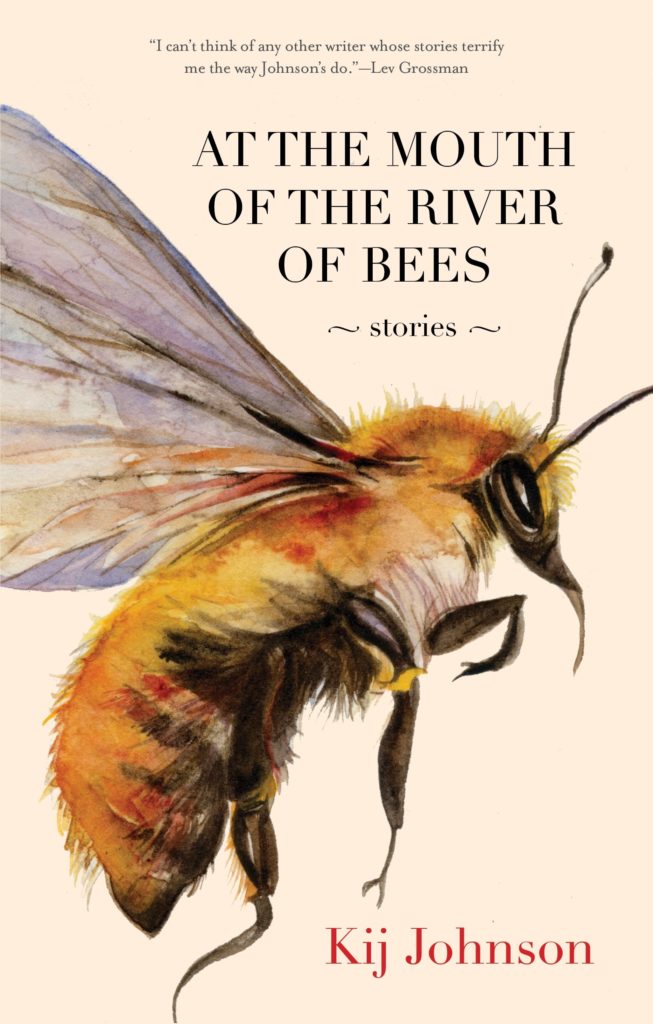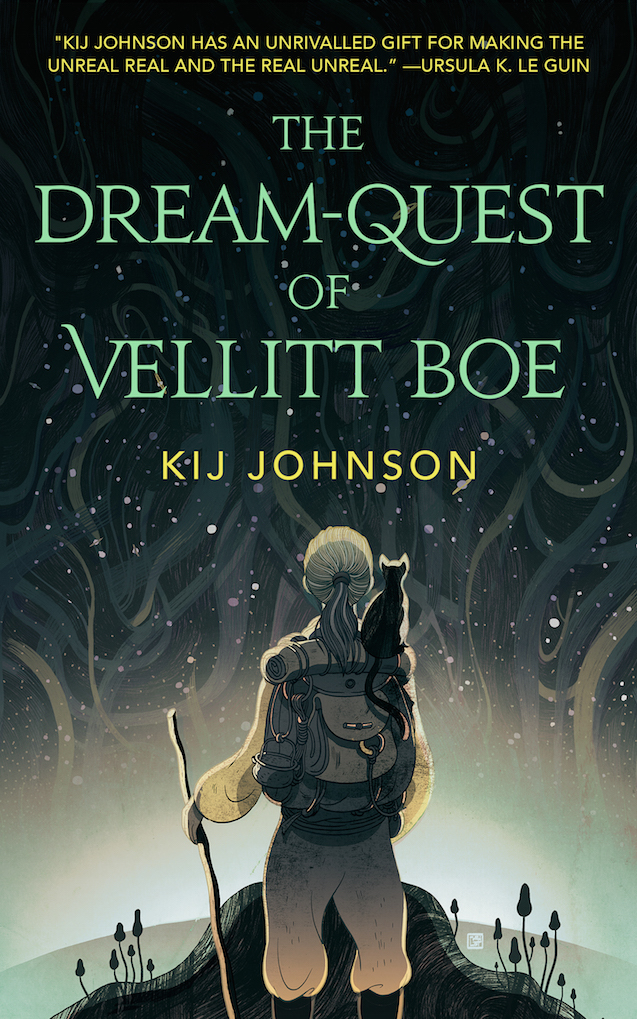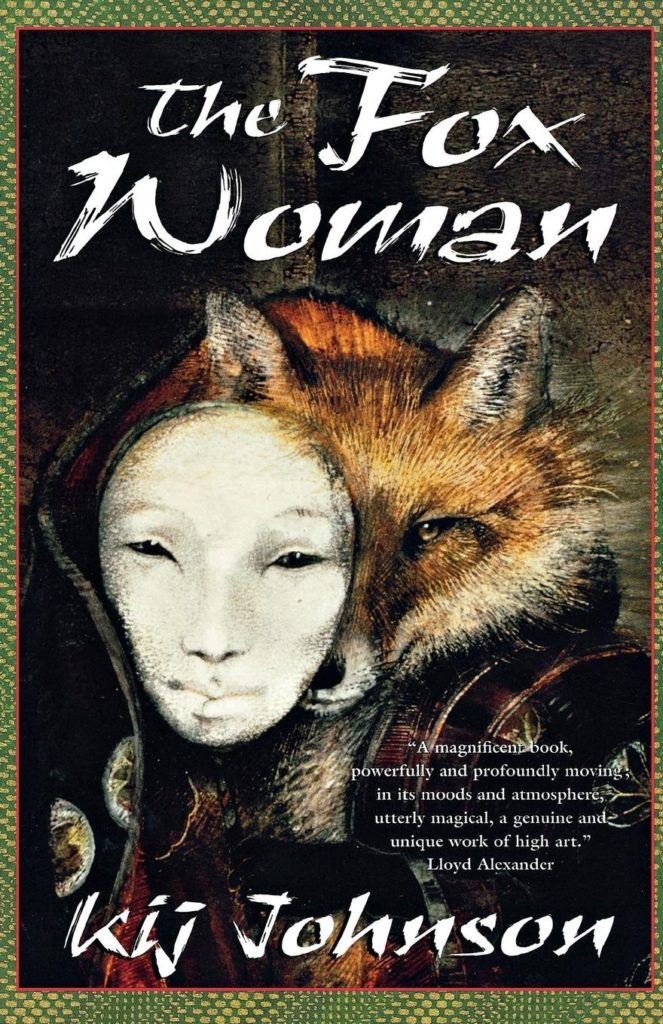They might not be raindrops on roses or whiskers on kittens, but that doesn’t mean that we love them any less. Welcome back to My Favorite Things, the weekly column where we grab someone in speculative circles to gab about the greatest in geek. This week, we sit down with award winning author Kij Johnson, whose book, The Fox Woman, is our book club selection for March, which we’ll be discussing on Friday!
What does Kij love when she’s not writing award-winning fiction? Spoiler alert: women who should show up more often in spec fic, secret lives in a delicate fantasy, a book that isn’t as juvenile as some would assume, and Scandinavian noir. Intrigued? Read on to learn more!
My tastes are all over the map. I adore Tristram Shandy, the Leverage TV series, nineteenth-century Icelandic travelogues, and Georgette Heyer’s Regency novels, but none of these are SF or fantasy, alas. But here are some things I love, and by “love,” I mean “can’t stop talking about to my friends.”
Silver-haired feral dragon ladies: I wrote The Dream-Quest of Vellitt Boe in 2017 because there wasn’t anyone in all of literature or film that I wanted to grow up to be, no role models for lives I might want to live. I am 58, and until five years ago, my options as per Hollywood and most SF/F novels were (1) various grandmotherly types, (2) cat ladies at various levels of pathetic-ness, and (3) hard-nosed political leaders. (Yes, I am looking at you, Elysium and Divergent and Hunger Games and Guardians of the Galaxy and Independence Day 2 and Battlestar Galactica.) Most characters my age or older are defined by their husbands and children — or grandchildren! — or their lack of same. The political ones have pantsuits and icy pageboy haircuts, and get to snarl at the meddling kids who are fixing the world in spite of them, but even so, no matter what,  what they aren’t is badass in any way I would want to be badass. But then there is Valka in How to Train Your Dragon 2; Mary Winchester in the Supernatural TV series; Janet Van Dyne in Ant-Man and the Wasp; and Atlanna in Aquaman. And others. All are tough women in their fifties who had survived impossible situations, and even thrived, ending up with great weapons and fantastic hair.
what they aren’t is badass in any way I would want to be badass. But then there is Valka in How to Train Your Dragon 2; Mary Winchester in the Supernatural TV series; Janet Van Dyne in Ant-Man and the Wasp; and Atlanna in Aquaman. And others. All are tough women in their fifties who had survived impossible situations, and even thrived, ending up with great weapons and fantastic hair.
I do have some issues with the feral dragon ladies. The four I just listed were all initially forced into their adventures: none of them chose to rough it at subatomic levels or in monster-haunted caverns or Hell. Even Valka, who was at first stolen but decided to remain, is a stereotype we have seen before writ large: the crazy middle-aged single lady who rescues cats or mustangs or circus tigers. (Though, to be fair, Valka is awesome in an entirely unique way: a woman who prioritized her life’s mission over her family.) And all of these women are initially important to their settings only because of their husbands and who their children are, alas.
But baby steps. All of these women moved me to tears, and it certainly wasn’t always for the writing, or even the acting. I was just so happy to see any representation of a woman my age with bigger fish to fry than, well, frying fish.
The Secret Life of Walter Mitty : I just watched it again last night, and I love almost everything about this movie. Do I have to try and describe what works for me? Some of it is the delicacy of the fantasy element. Does Walter Mitty actually fight off a shark with a Zero-Halliburton briefcase, off the Greenland shore? Who knows? But something has happened, something that changes Walter Mitty in profound ways. How are hand-assisted slides using basalt and a ripped-up necktie down an icelandic road any more likely than a poetry falcon? What about the whole idea of falling in love at that age, for someone so shy? Walter Mitty’s real life — New York, the magazine shut-down, the eHarmony account — feels as unreal as his fantasy life, so how can we tell where the line is? It’s also an incredibly satisfying movie about what it’s like to be middle aged and still longing for magic in the world: the real magic of satisfying work and love; the strange magic of new horizons and unfamiliar skies; the impossible magic of poetry falcons and wing walking into a volcanic eruption.
: I just watched it again last night, and I love almost everything about this movie. Do I have to try and describe what works for me? Some of it is the delicacy of the fantasy element. Does Walter Mitty actually fight off a shark with a Zero-Halliburton briefcase, off the Greenland shore? Who knows? But something has happened, something that changes Walter Mitty in profound ways. How are hand-assisted slides using basalt and a ripped-up necktie down an icelandic road any more likely than a poetry falcon? What about the whole idea of falling in love at that age, for someone so shy? Walter Mitty’s real life — New York, the magazine shut-down, the eHarmony account — feels as unreal as his fantasy life, so how can we tell where the line is? It’s also an incredibly satisfying movie about what it’s like to be middle aged and still longing for magic in the world: the real magic of satisfying work and love; the strange magic of new horizons and unfamiliar skies; the impossible magic of poetry falcons and wing walking into a volcanic eruption.
The production design is part of this, as well, with many tiny details that support the theme. Walter Mitty’s eyes, his apartment, and the icebergs off Greenland are all the same blue-green color. Hmm…
 The fantasy book I never, ever get tired of is Watership Down, by Robert Adams. It is the reason I write from the points of view of animals (we now call it xenofiction), the reason I am so fond of the intrusive authorial voice, the reason I invent myths, the reason I notice clouds when I go for a walk, the reason I write. There was a long period when I felt I had to defend this choice — plenty of people thought (and perhaps still think) that an adventure story about talking rabbits was by definition juvenile — but in recent years, it seems as though the book has finally been seen for what it is: sui generis, a brilliant, moving epic: noble, ambitious, elegant, and heartbreaking.
The fantasy book I never, ever get tired of is Watership Down, by Robert Adams. It is the reason I write from the points of view of animals (we now call it xenofiction), the reason I am so fond of the intrusive authorial voice, the reason I invent myths, the reason I notice clouds when I go for a walk, the reason I write. There was a long period when I felt I had to defend this choice — plenty of people thought (and perhaps still think) that an adventure story about talking rabbits was by definition juvenile — but in recent years, it seems as though the book has finally been seen for what it is: sui generis, a brilliant, moving epic: noble, ambitious, elegant, and heartbreaking.
But I am sure we can say that about lots of books, right? So why this one for me? Well, for one thing, Adams (like Maj Sjöwall and Per Wahlöö; see below) changed everything we expected from an animal story — and from a fantasy. Certainly there had been plenty of books told from the points of views of animals before this — Black Beauty, Call of the Wild, so many more — but their stories were realistic and never so lyrical. The characters were never as vivid as Hazel and Fiver and Bigwig and all the rest. Fact is, a great writer can build profound beauty from anything — and that was my biggest lesson from Adams.
 Murder on the Thirty-First Floor, by Per Wahlöö. Per Wahlöö is best known for the Martin Beck mysteries, which he wrote with his partner, Maj Sjöwall. (Stick with me.) Scandinavian noir as a mystery subgenre exists because of this couple in the same way that urban fantasy exists because of War for the Oaks by Emma Bull: they invented the rules that everyone since has played by or tried to subvert, whether they know it or not. In the 1960s, two Swedish journalists started a mystery series titled The Art of Detection: a bold title, coming as the series did in the goldenest part of the Golden Age of detective fiction. There were ten books total, set in the police bureau responsible for murders in the country. The cast was large and constantly shifting, centered always on the detective Martin Beck. The mysteries were interesting and took plot and characterization chances no one would have believed you could pull off (especially in the 1960s and 70s); but in fact the authors wrote the series as serious social commentary on Sweden’s economic and social problems. The style was absolutely arid, a pure version of the minimalistic voice we tend to associate with noir, but simultaneously elegant in a way I can’t put my finger on, even though I teach style and voice for a living. I devoured the books last fall, and then reread them immediately, trying to figure out how they manage to create such interesting work.
Murder on the Thirty-First Floor, by Per Wahlöö. Per Wahlöö is best known for the Martin Beck mysteries, which he wrote with his partner, Maj Sjöwall. (Stick with me.) Scandinavian noir as a mystery subgenre exists because of this couple in the same way that urban fantasy exists because of War for the Oaks by Emma Bull: they invented the rules that everyone since has played by or tried to subvert, whether they know it or not. In the 1960s, two Swedish journalists started a mystery series titled The Art of Detection: a bold title, coming as the series did in the goldenest part of the Golden Age of detective fiction. There were ten books total, set in the police bureau responsible for murders in the country. The cast was large and constantly shifting, centered always on the detective Martin Beck. The mysteries were interesting and took plot and characterization chances no one would have believed you could pull off (especially in the 1960s and 70s); but in fact the authors wrote the series as serious social commentary on Sweden’s economic and social problems. The style was absolutely arid, a pure version of the minimalistic voice we tend to associate with noir, but simultaneously elegant in a way I can’t put my finger on, even though I teach style and voice for a living. I devoured the books last fall, and then reread them immediately, trying to figure out how they manage to create such interesting work.
But I was disappointed that there were only ten books in the series, so I went prowling. And found Murder of the Thirty-First Floor, by Per Wahlöö (no Maj). As with the Martin Beck books, it’s a police procedural, but it is set in an unnamed country, in an undated near future (to 1964). It’s a little bit 1984 and a little bit Kafka, dark and absolutely Brutalist in conception and execution. The detective — can I even call him a hero, when he is so opaque? — Chief Inspector Jensen — is called in when the country’s biggest media conglomerate receives a false bomb threat referring to a murder that apparently never happened. Watching him unveil the realities of his dystopian world is harrowing. It’s also horrifyingly prescient.
 Kij Johnson writes short fiction and novels that are usually speculative, but sometimes uncategorizable. She has won the Hugo Award, the Nebula (three times), the World Fantasy Award (twice), the Theodore Sturgeon Award, and the Grand Prix de l’Imaginaire. She teaches creative writing at the University of Kansas, where she is also the associate director for the Gunn center for the Study of Science Fiction. She leads workshops on writing the novel for the Center each summer, and has taught at Clarion, Clarion West, Odyssey, and GenCon.
Kij Johnson writes short fiction and novels that are usually speculative, but sometimes uncategorizable. She has won the Hugo Award, the Nebula (three times), the World Fantasy Award (twice), the Theodore Sturgeon Award, and the Grand Prix de l’Imaginaire. She teaches creative writing at the University of Kansas, where she is also the associate director for the Gunn center for the Study of Science Fiction. She leads workshops on writing the novel for the Center each summer, and has taught at Clarion, Clarion West, Odyssey, and GenCon.
For news and musings, follow Kij’s blog, at http://kijjohnson.com/
She also posts unpublished fiction and poetry at her Patreon, at https://www.patreon.com/kijjohnson
Author Photo by Salon di Marco
Would you like to write about YOUR favorite things for Speculative Chic? Check out our guidelines and fill out the form here.





I never get tired of Watership Down either! I don’t know why, but ever since stumbling upon it when I was in 7th or 8th grade (after reading a lot of Brian Jacques and seeing quotes on the covers reference Watership Down), I’ve read it more than any other book on my shelf. I remember once in high school my sister’s friend was in a class that was reading it. He wasn’t into it but still needed to know what was going on, so he would come to me and ask for summaries. The whole concept amused me to no end so I went ahead and helped him.
Me: “Ok, so what’s going on?”
Guy: “Something about Bigwig and a lot of weird rabbits?”
Me: “HOO BOY, LET ME TELL YOU WHAT.”
I got the book free from my middle school library because they were giving away a lot of books that were older and in less than stellar shape, and I was so excited! Finally that copy fell apart and I had to buy a new one. Still have that second copy on my shelf. I think I might have to get it out and read it again sometime soon, now.
I, to my shame, have never read Watership Down. My only real memory of that book comes from the first season of Lost, when Sawyer is reading it and says it’s about bunnies.